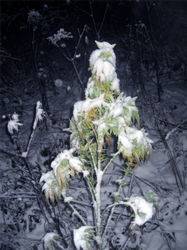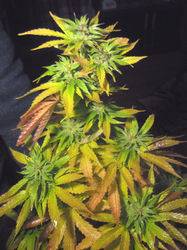Fat Albert
Active member
This thread was inspired by Sleepy's thread about harvest time.
Determining harvest time for sativas is an imperfect science at best, given that they're much more photoperiod-independent than indicas . Even when one tips the light from 13/11 to 11/13 it takes the plant a while to wind up indicating. Also, given that most can have a second season if planted at the right time and adequately cared for, this makes the determination of harvesting even more uncertain.
Here's something that I've been thinking a lot about, in terms of photoperiod manipulation for indica-dominant strains (actually most strains that are not landrace sativas such as Thai or Columbian). The further away from the equator one gets, the more of a 'spike' one sees in total sunlight from one equinox to another (March to September above the equator). The apotheosis of this phenomenon is observed at the Arctic circle, where one goes from 0 hours daylight on December 21, to 12 hours daylight on March 21, to 24 hours daylight on June 21! As one gets closer to the equator, this bell curve shifts somewhat, by flattening out at the top and not running into the x-axis on either end. An equatorial bell curve is almost flat, reflecting the small total change in photoperiod during the whole year.

At my latitude, the longest day length is 15.01 hours (solar day length), from June 19 to June 23. It starts declining from there. At August 1, day length is 14.21 hours. At the autumnal equinox, day length is 12.06 hours. At this date, virtually all points above the equator are approximately 12 hours.
Here's the calculator:
http://www.jgiesen.de/astro/astroJS/decEoT/index.htm
Now, strict light-cycle analysis would conclude that the plants would not indicate sex until after the autumnal equinox, given that that's when solar daylight begins to fall under our INDOOR critical benchmark. Yet anybody who's ever grown outdoors knows that by September 21, one's plants are WAY BEYOND showing sex. Indeed, most are close to harvest by that point. That would lead one to conclude that the critical factor in sexing and budding is the CONSTANT, STEADY DECLINE IN AVAILABLE LIGHT. The further north one goes, the more rapid the decline in day length is after the solstice. Examining the characteristics of a cannabis ruderalis strain seems to bolster the argument that strains native to climates far from the equator are genetically inclined to have a hyper-sensitive photoperiod response.
I am speculating about what kind of useful knowledge can be gleaned from manipulating the photoperiod of indoor plants in a manner similar to the day length that the plant's natural genetics respond to. An indica-dominant strain may show sex more rapidly while attaining a greater TOTAL GROWTH if one was to begin vegging under a certain day length (say 18 hours). Then, if there is a timer that can support this, one might be able to decrease the photoperiod by increments of a few minutes per day (let's say 10 minutes per day). After a period of 36 days, one would get to the 12/12 benchmark. If a plant's OUTDOOR behavior can provide any sort of insight, then THEORETICALLY by the time this benchmark is reached, the plant would already be showing sex, and probably budding by this point. If one was to further study temporal differences in the day length differences determined by latitude (distance from the equator), then one might be able to tinker with day length differences to simulate different latitudes. If one starts at 18/6 and gets to 12/12 within 36 days, that would simulate the light cycle at 70'N, which has 18 hours at August 21, and is down to 12 hours by September 21. A daily change of 5 minutes would mean that it takes 72 days to reach 12/12. That would simulate outdoor conditions at 60' N. Conditions at 40'N would require 71 days from the solstice (June 21) to the equinox (September 21). One could theoretically make a crude determination of the landrace origins of the strain that one is growing by examining the plant's overall growth and sexing in response to a predetermined photoperiod schedule by latitude. For instance, if you use the 50'N timing and after 72 days your plant hasn't indicated, it's probably heavily sativa-dominant. If on the other hand it's got amber trichomes, it's probably rudy, baby.
I understand that the practical application of this theory may not be the easiest or most efficient way of growing indoors. However, I think that it may have tremendous uses for the breeder who is trying to determine appropriate strains for breeding and is trying to select plants with a specific photoperiod characteristic. Vegging under 24 hours of light and switching to 12/12 will not show the TRUE photoperiod of response of a plant. Sure, some may pre-flower during veg or show sex slower than others under 12/12, but one will not know the plant's true response to a changing photoperiod. I think that for breeding outdoor strains this information would be of critical importance.
I'd be interested to hear what others have to think about this. Perhaps this is just the delusional ranting of a fishing-obsessed grower, but I think it may have some use someday.
Cheers!
Fat A
Determining harvest time for sativas is an imperfect science at best, given that they're much more photoperiod-independent than indicas . Even when one tips the light from 13/11 to 11/13 it takes the plant a while to wind up indicating. Also, given that most can have a second season if planted at the right time and adequately cared for, this makes the determination of harvesting even more uncertain.
Here's something that I've been thinking a lot about, in terms of photoperiod manipulation for indica-dominant strains (actually most strains that are not landrace sativas such as Thai or Columbian). The further away from the equator one gets, the more of a 'spike' one sees in total sunlight from one equinox to another (March to September above the equator). The apotheosis of this phenomenon is observed at the Arctic circle, where one goes from 0 hours daylight on December 21, to 12 hours daylight on March 21, to 24 hours daylight on June 21! As one gets closer to the equator, this bell curve shifts somewhat, by flattening out at the top and not running into the x-axis on either end. An equatorial bell curve is almost flat, reflecting the small total change in photoperiod during the whole year.
At my latitude, the longest day length is 15.01 hours (solar day length), from June 19 to June 23. It starts declining from there. At August 1, day length is 14.21 hours. At the autumnal equinox, day length is 12.06 hours. At this date, virtually all points above the equator are approximately 12 hours.
Here's the calculator:
http://www.jgiesen.de/astro/astroJS/decEoT/index.htm
Now, strict light-cycle analysis would conclude that the plants would not indicate sex until after the autumnal equinox, given that that's when solar daylight begins to fall under our INDOOR critical benchmark. Yet anybody who's ever grown outdoors knows that by September 21, one's plants are WAY BEYOND showing sex. Indeed, most are close to harvest by that point. That would lead one to conclude that the critical factor in sexing and budding is the CONSTANT, STEADY DECLINE IN AVAILABLE LIGHT. The further north one goes, the more rapid the decline in day length is after the solstice. Examining the characteristics of a cannabis ruderalis strain seems to bolster the argument that strains native to climates far from the equator are genetically inclined to have a hyper-sensitive photoperiod response.
I am speculating about what kind of useful knowledge can be gleaned from manipulating the photoperiod of indoor plants in a manner similar to the day length that the plant's natural genetics respond to. An indica-dominant strain may show sex more rapidly while attaining a greater TOTAL GROWTH if one was to begin vegging under a certain day length (say 18 hours). Then, if there is a timer that can support this, one might be able to decrease the photoperiod by increments of a few minutes per day (let's say 10 minutes per day). After a period of 36 days, one would get to the 12/12 benchmark. If a plant's OUTDOOR behavior can provide any sort of insight, then THEORETICALLY by the time this benchmark is reached, the plant would already be showing sex, and probably budding by this point. If one was to further study temporal differences in the day length differences determined by latitude (distance from the equator), then one might be able to tinker with day length differences to simulate different latitudes. If one starts at 18/6 and gets to 12/12 within 36 days, that would simulate the light cycle at 70'N, which has 18 hours at August 21, and is down to 12 hours by September 21. A daily change of 5 minutes would mean that it takes 72 days to reach 12/12. That would simulate outdoor conditions at 60' N. Conditions at 40'N would require 71 days from the solstice (June 21) to the equinox (September 21). One could theoretically make a crude determination of the landrace origins of the strain that one is growing by examining the plant's overall growth and sexing in response to a predetermined photoperiod schedule by latitude. For instance, if you use the 50'N timing and after 72 days your plant hasn't indicated, it's probably heavily sativa-dominant. If on the other hand it's got amber trichomes, it's probably rudy, baby.

I understand that the practical application of this theory may not be the easiest or most efficient way of growing indoors. However, I think that it may have tremendous uses for the breeder who is trying to determine appropriate strains for breeding and is trying to select plants with a specific photoperiod characteristic. Vegging under 24 hours of light and switching to 12/12 will not show the TRUE photoperiod of response of a plant. Sure, some may pre-flower during veg or show sex slower than others under 12/12, but one will not know the plant's true response to a changing photoperiod. I think that for breeding outdoor strains this information would be of critical importance.
I'd be interested to hear what others have to think about this. Perhaps this is just the delusional ranting of a fishing-obsessed grower, but I think it may have some use someday.
Cheers!
Fat A









